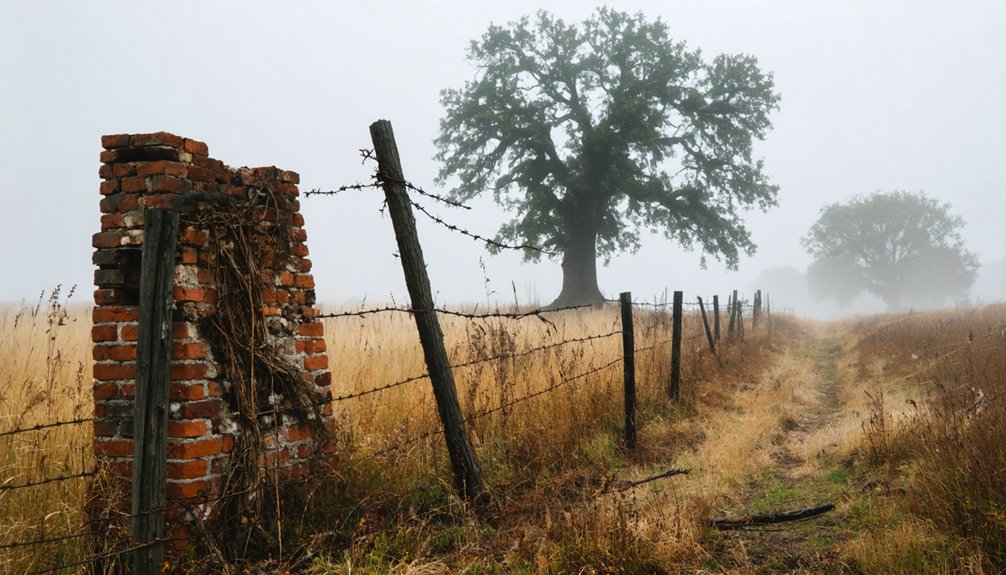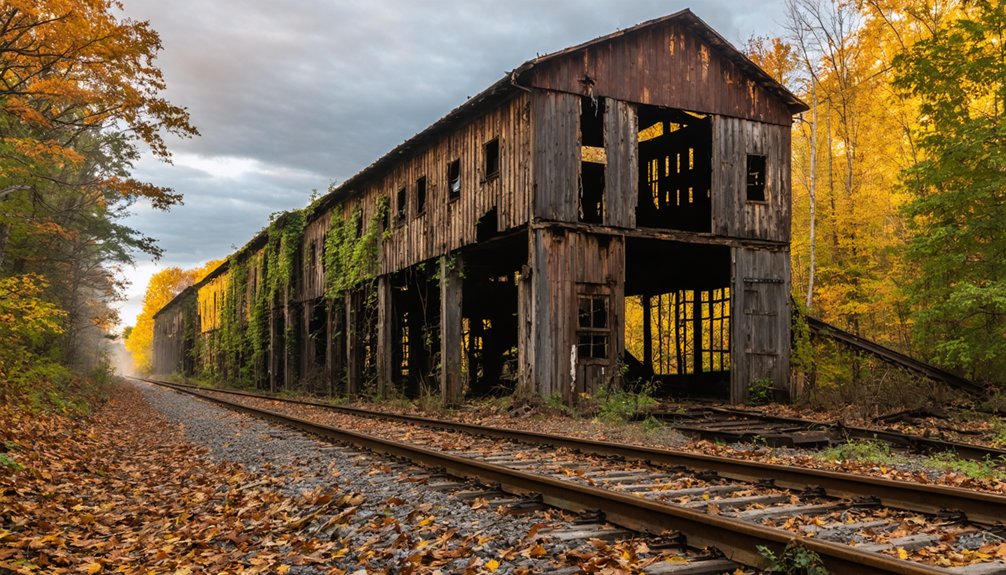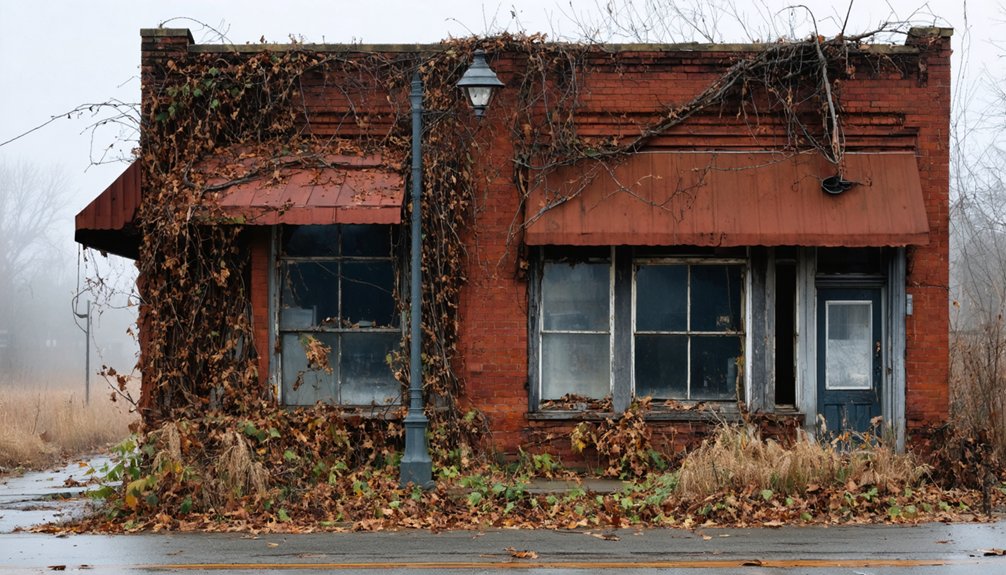You’ll find Walnut Grove’s ghost town story tucked away in Knox County, Indiana, where it emerged in the early 1800s as a pioneering settlement. With dense timber stands and protective wetlands, the community grew to 50 residents, centered around farming and a bustling post office established in 1872. Despite its agricultural success, the town’s isolation and lack of railroad connections led to its abandonment by 1900. The town’s vanished structures and buried history hold countless untold tales.
Key Takeaways
- Walnut Grove was a small farming community in Warren County with approximately 50 residents during its peak in the late 1800s.
- The town operated a post office from 1872 to 1900, serving as a vital communication hub for local farmers.
- Agricultural challenges, including a grasshopper plague in 1870 and lack of railroad access, contributed to the town’s decline.
- Water supply issues and isolation from trade networks ultimately led to the community’s abandonment by the early 1900s.
- No significant structures remain today, with all traces of the original settlement lost beneath modern agricultural fields.
The Rise of a Prairie Settlement
While the untamed prairie stretched endlessly across Knox County in the early 1800s, Walnut Grove emerged as a promising settlement site due to its dense timber stands and natural resources.
You’d find towering black walnut, sugar maple, and cherry trees thriving alongside protective sloughs and wetlands that shielded the area from devastating prairie fires.
The settler challenges were intimidating when John Thompson arrived in 1836 – his nearest neighbor lived eleven miles away at Fraker’s Grove.
In 1836, isolation tested the bravest pioneers, with Thompson’s closest neighbor an exhausting eleven-mile journey through untamed wilderness.
Yet community dynamics slowly took shape as more pioneers claimed the land. You could witness the transformation through newly carved wagon tracks, rising log cabins, and growing relationships with the local Native American band of 30 who initially camped nearby.
The rich timber and fertile soil promised freedom and prosperity for those brave enough to stake their claim. Their dedication to education was evident when they built their first schoolhouse around 1841.
The township contained mostly prairie lands with only 100 acres of valuable timber remaining for early settlers.
Life in 19th Century Walnut Grove
As the post office opened its doors in 1872, Walnut Grove took shape as a close-knit farming community of about 50 residents.
You’d find folks gathering at community events centered around harvests and religious celebrations, where neighbors supported each other through the challenges of prairie life. Similar to Robert Preston’s plantation, local agriculture relied heavily on enslaved labor during this era. Residents also frequented the master tanner’s shop for their leather goods. The town’s social traditions emerged from shared resources and mutual reliance – whether you needed help with farm work or organizing local festivities.
Daily life revolved around agriculture, with your success depending heavily on weather conditions and market access.
You’d rely on postal services for communication and horse-drawn transportation along basic dirt roads. While the town lacked extensive infrastructure, you’d find strength in the tight bonds between families who worked together, celebrated together, and faced hardships as one united community.
Agricultural Roots and Local Economy
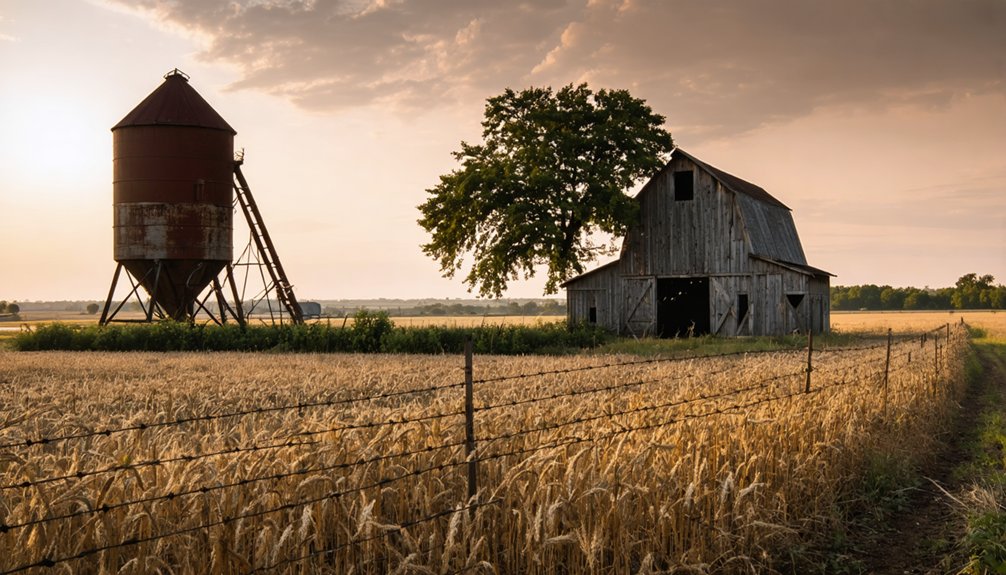
When Walnut Grove took root in the 1830s, agriculture formed the bedrock of its economy, with the Charles family’s expansive cattle operation leading the way.
You’d find their Walnut Grove Farm sprawling across 1,200 acres by 1890, featuring European-imported stock and sustainable practices that set standards for the region.
The area’s agricultural prowess extended beyond cattle. Local farmers managed 10-30 acre walnut groves, while John Wood’s sawmill and gristmill, established in 1837, processed the community’s grain harvests.
The iconic stone barn, built around 1865, wasn’t just a hub for farming – it became central to community events. Barn Again! initiatives helped preserve this historic structure for future generations.
Even during WWII, you’d see women’s cooperative harvesting groups stepping up to maintain the town’s agricultural output, showcasing the resilient spirit that defined Walnut Grove’s farming heritage.
Workers used long poles or mallets to harvest walnuts before modern equipment was introduced.
The Path to Abandonment
You’ll find that Walnut Grove’s decline mirrored many farming communities that missed out on crucial railroad connections in the late 1800s.
While neighboring towns prospered along new transportation routes, your ancestors in Walnut Grove watched their agricultural prospects dwindle as markets became harder to reach.
The town’s isolation from emerging trade networks, combined with its purely agricultural economy, left local farmers with few options to sustain their livelihoods.
The community’s resilience was tested early when a devastating grasshopper plague in 1870 nearly wiped out their agricultural foundation.
Like many ghost towns, Walnut Grove’s struggle to maintain access to clean water sources further accelerated its eventual abandonment.
Transportation Routes Changed
The evolving transportation landscape of 19th-century Indiana dealt a devastating blow to Walnut Grove’s future. As you study the area’s transportation history, you’ll find that railroad companies deliberately bypassed the small settlement, instead favoring established commercial centers. This route significance proved fatal for Walnut Grove’s development.
When the automotive age arrived, you’d have seen even more changes reshape the region. While other towns benefited from new highways and steel bridges, Walnut Grove remained isolated from major transport corridors. Local residents claim that eerie sounds can be heard from abandoned steel bridges in the area. Much like the town of Liberty that became Galt, which thrived after becoming a stagecoach stop in 1861, Walnut Grove needed key transportation connections to survive.
The 1900 closure of the town’s post office, which had operated since 1872, marked a turning point. Without rail connections or major roadways, businesses and residents gradually relocated to better-connected communities, leaving Walnut Grove to fade into obscurity.
Agricultural Economy Declined
Beyond Walnut Grove’s transportation woes, mounting agricultural challenges sealed the town’s fate.
You’d have witnessed the dramatic change as family farms, once the backbone of the community’s economic sustainability, gave way to large-scale operations. While your grandparents might’ve worked a modest 102-acre farm in 1925, by 2014 you’d need at least 253 acres just to compete.
The agricultural transformations hit Walnut Grove particularly hard. Your neighbors faced relentless pressures: soil depletion, crop diseases, and limited access to modern farming equipment.
Without the capital for mechanization, many couldn’t keep up with industrial farming’s efficiency. As land values rose, you’d have seen longtime farmers selling their properties, their children seeking urban opportunities.
The farming community that had sustained Walnut Grove for generations simply couldn’t survive these transformative pressures.
Traces Lost to Time
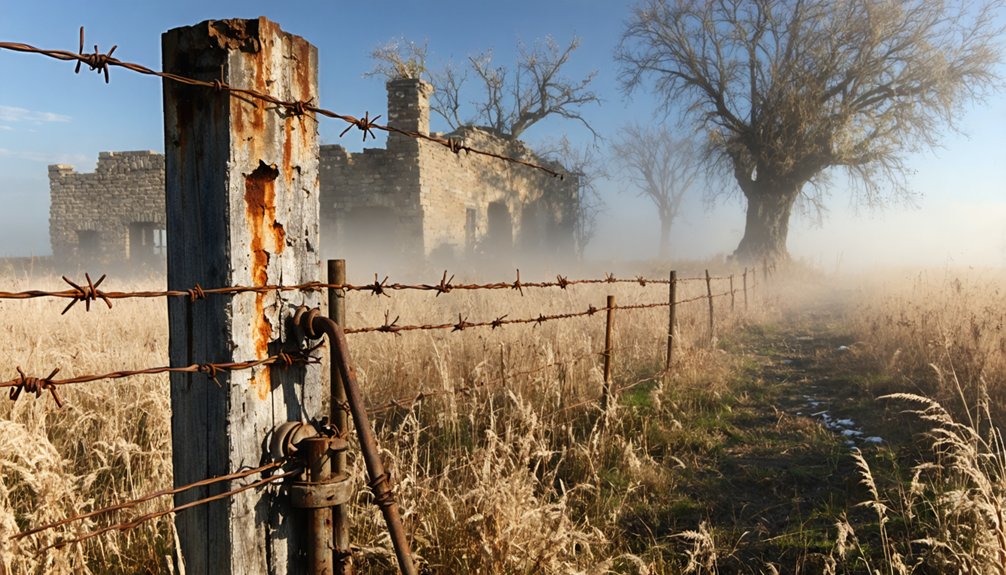
Located at the intersection of County Roads 650 North and 500 West in Prairie Township, Walnut Grove’s physical remnants have largely vanished beneath Warren County’s agricultural landscape.
You’ll find no prominent standing structures or ruins from the original settlement, as decades of farming have erased most traces of this pioneer community.
Archaeological challenges abound, with building footprints lost to time and agricultural activity.
While historical documentation confirms the town’s existence through postal records from 1872 to 1900 and mentions a population of about 50 residents in 1913, you won’t find many photographs or detailed maps of the original layout.
Local historical societies preserve the town’s memory, but without formal excavations or heritage protection, the physical evidence of this once-thriving settlement continues to fade into the fertile Indiana soil.
Legacy in Warren County
You’ll find Walnut Grove’s lasting impact most evident in the area’s enduring agricultural tradition, where today’s farms echo the pioneering spirit of early settlers like Levi Van Reed.
While the physical town has vanished, its memory persists through Warren County’s historical records and family histories that document its brief but notable existence as a rural post stop.
The settlement’s story, though increasingly distant, remains woven into the broader narrative of Warren County’s agricultural development and serves as a tribute to the region’s rural roots.
Agricultural Heritage Remains
Warren County’s rich agricultural legacy endures through impressive production figures that rival its historic peaks, with modern farms producing over 17 million bushels of corn annually across 95,000 acres.
You’ll find this heritage preservation evident in the county’s continued agricultural dominance, where 86% of the land remains dedicated to farming – a tradition dating back to the 1830s when pioneers like Isaac Bartlett first broke ground in Walnut Grove Township.
While the early days saw wheat and hay production drive the economy, today’s farming traditions have evolved to include extensive soybean cultivation alongside corn.
The same creeks that once powered grist mills still weave through the landscape, reminding you of the resilient spirit that transformed this frontier into one of Indiana’s most productive agricultural regions.
Local Memory Fades Away
Despite its once-thriving presence in Prairie Township, Walnut Grove has largely vanished from local memory since its post office closed in 1900.
Today, you’ll find only flat farmland and county roads where this small town of 50 residents once stood.
Memory preservation efforts continue through the Walnut Grove Historical Society, which maintains the Morgan-Skinner-Boyd Homestead’s legacy on both National and Indiana State Historic Registries.
Community nostalgia lives on through genealogical records and the stories of pioneer families like the Van Reeds and Hogshetts.
Yet, as Warren County evolved, shifting transportation routes and changing economic patterns drew people away from small farming communities.
While descendants of early settlers keep their family histories alive, Walnut Grove’s broader cultural impact has dimmed, becoming just another quiet chapter in the county’s rural transformation.
Frequently Asked Questions
Were There Any Notable Crimes or Incidents Reported in Walnut Grove?
You won’t find any unsolved mysteries or major crimes in historical records here. The community maintained a peaceful existence, with normal hardships but no documented criminal incidents worth noting.
Did Native American Tribes Have Settlements in the Area Before?
Like shadows across time, you’ll find little evidence of Native settlements directly in the area, though Miami, Wea, and Shawnee tribes moved through the broader region during their tribal history.
What Happened to the Cemetery or Burial Grounds?
You’ll find the cemetery still exists in Richland Township, though it’s minimally maintained. While some markers have weathered away, the burial grounds remain largely intact despite limited preservation efforts.
Were There Any Schools or Churches Serving the Community?
Like a fading footprint in fresh snow, you won’t find any recorded school history or church architecture here. The tiny community likely relied on nearby towns or home-based gatherings for education and worship.
Did Any Famous People or Events Originate From Walnut Grove?
You won’t find any famous residents or nationally significant events originating here. While local pioneers like Lafayette Bedal and the Morgan family held community importance, they didn’t achieve wider historical significance.
References
- https://www.heraldtimesonline.com/story/news/local/2021/10/26/most-haunted-places-locations-halloween-southern-indiana-bloomington-lawrence-county-monroe-mitchell/6116435001/
- https://walnutgrove.org/walnut-grove-history/
- https://www.youtube.com/watch?v=45D4dbASJyE
- https://walnutgrovehistory.org/home/
- https://en.wikipedia.org/wiki/Walnut_Grove
- https://www.wikiwand.com/en/map/Walnut_Grove
- https://walnutgrovehistory.org
- https://en.wikipedia.org/wiki/List_of_ghost_towns_in_Indiana
- https://mcdonough.illinoisgenweb.org/1885twpwalnutgrove.html
- https://knox.illinoisgenweb.org/histwpwalnutgrove.htm
